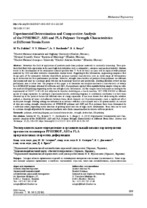| dc.contributor.author | Zalohin, M. Yu. | |
| dc.contributor.author | Skliarov, V. V. | |
| dc.contributor.author | Dovzhenko, Ja. S. | |
| dc.contributor.author | Brega, D. A. | |
| dc.coverage.spatial | Минск | ru |
| dc.date.accessioned | 2019-07-04T11:03:28Z | |
| dc.date.available | 2019-07-04T11:03:28Z | |
| dc.date.issued | 2019 | |
| dc.identifier.citation | Experimental Determination and Comparative Analysis of the PPH030GP, ABS and PLA Polymer Strength Characteristics at Different Strain Rates = Экспериментальное определение и сравнительный анализ характеристик прочности полимеров PPH030GP, ABS и PLA при различных скоростях деформации / M. Yu. Zalohin [et al.] // Наука и техника. – 2019. – № 3. – С. 233-239. | ru |
| dc.identifier.uri | https://rep.bntu.by/handle/data/54327 | |
| dc.description.abstract | Nowadays the field of application of products made from polymer materials is constantly increasing. These products find their wide application in the most high-tech industries such as automotive, aerospace and medical industry. Modern trends in the development of the automotive industry predicts that 75 % of the total car mass will be replaced with polymer materials by 2020 and other industries demonstrate similar trends. Regarding to this information, engineering companies that design parts of the automotive industry should have polymer material characteristics over an entire range of deformations up to destruction for their performance prediction. However, strength characteristics of products from polymers are different and depend not only on a polymer grade but also on technology used for part production. Existing literature review on this problematic area is rather rare. The purpose of this paper is to determine and analyze mechanical characteristics of widely used PPH030GP polymer obtained by extrusion and ABS, PLA polymers applied while manufacturing samples using an additive method (3D-printing) depending on the rate of high-elastic deformation. All the samples have been made according to the requirements of GOST 11262–80 and subjected to uniaxial stretching on a tensile machine UIT STM 050/300 at different speeds of clamp expansion. According to experimental results, stretching diagrams in conditional coordinates σ–ε have been obtained up to the point of failure for different rates of clamp expansion. It has been shown that while using the additive method, a direction of layers and adhesion between them, which depends on 3D-print parameters, have a significant effect on the part strength. Printing settings are indicated in accordance with the selected mode and a 3D-printer model. As a result of data processing, strength characteristics of PPH030GP polymer and ABS and PLA polymers have been determined to a sufficient extent, depending on the direction of printing layers and rate of high-elastic deformation. These data can be used to calculate strength of products by numerical methods and a finite element method in various software products. | ru |
| dc.language.iso | en | ru |
| dc.publisher | БНТУ | ru |
| dc.title | Experimental Determination and Comparative Analysis of the PPH030GP, ABS and PLA Polymer Strength Characteristics at Different Strain Rates | ru |
| dc.title.alternative | Экспериментальное определение и сравнительный анализ характеристик прочности полимеров PPH030GP, ABS и PLA при различных скоростях деформации | ru |
| dc.type | Article | ru |
| dc.identifier.doi | 10.21122/2227-1031-2019-18-3-233-239 | |
| local.description.annotation | Сегодня область применения изделий из полимерных материалов постоянно увеличивается. Такие изделия находят широкое применение в наиболее наукоемких отраслях, таких как автомобильная, аэрокосмическая и медицинская отрасли. Современные тенденции развития автомобильной промышленности прогнозируют к 2020 году 75 % общей массы автомобиля заменить полимерными материалами. Схожие тренды демонстрируют и другие отрасли. В связи с этим инженерным компаниям, проектирующим детали автомобильной промышленности, для прогнозирования их работоспособности необходимо иметь характеристики полимерных материалов во всем диапазоне деформаций – вплоть до разрушения. Однако прочностные характеристики изделий из полимеров различны и зависят не только от марки полимера, но и от технологии производства детали. Подробная информация в отечественной литературе встречается достаточно редко и в сжатом виде. Авторами статьи была поставлена задача определить и проанализировать механические характеристики широко применяемого полимера PPH030GP, полученного экструзивным методом, и полимеров ABS и PLA, применяемых при изготовлении образцов аддитивным методом (3D-печать) в зависимости от скорости деформации. Для этого были выполнены образцы согласно требованиям ГОСТ 11262–80 и подвергнуты одноосному растяжению на разрывной машине UIT STM 050/300 при разных скоростях раздвижения зажимов. По результатам экспериментальных исследований получены диаграммы растяжения в условных координатах σ–ε вплоть до момента разрушения для различных скоростей раздвижения зажимов. Показано, что при аддитивном методе значительное влияние на прочность изделия оказывают направление слоев и адгезия между ними, которая зависит от параметров 3D-печати. Параметры печати указаны в зависимости от выбранного режима и конструкции 3D-принтера. В результате обработки данных в достаточно полной мере определены прочностные характеристики полимеров PPH030GP, ABS и PLA в зависимости от направления слоев печати и скорости деформации. Эти данные можно применять для расчета прочности изделий численным методом и методом конечных элементов в различных программных продуктах. | ru |

